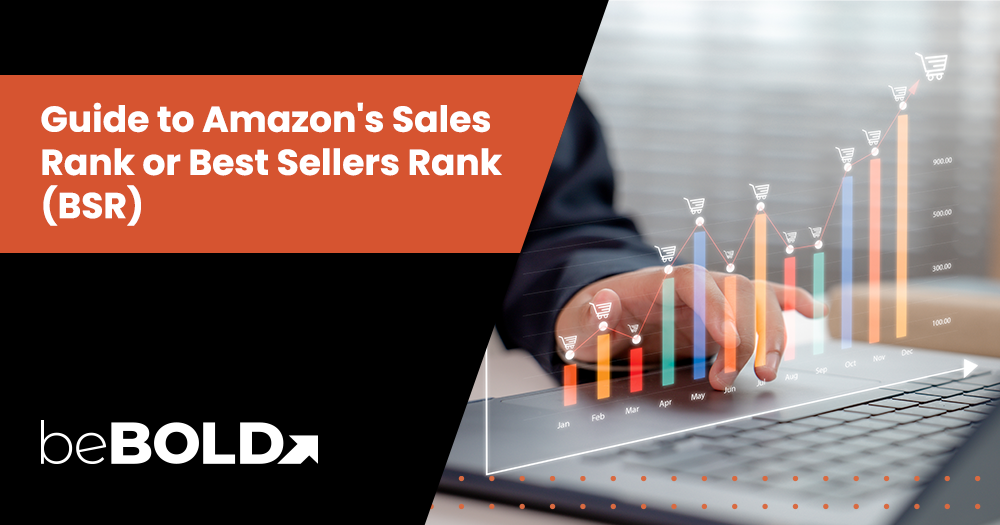Key Highlights
- BSR reflects real-time sales performance and is updated hourly based on recent and historical sales data within specific product categories.
- A lower BSR means higher sales velocity, but it doesn’t account for reviews, ratings, or profitability, only how well a product sells compared to others in its category.
- BSR is relative, not absolute, and products listed in multiple categories can have multiple BSRs at once.
- Sellers can’t directly control BSR, but sales-driven strategies, like PPC ads, listing optimization, and promotions, help improve it.
- BSR differs from organic ranking, which is influenced by keyword relevance and SEO; both metrics affect each other.
- Tools like Helium 10, Jungle Scout, and Amazon Seller Central help track BSR trends, sales velocity, and competitor positioning.
- Maintaining a strong BSR requires ongoing sales, stock availability, and continuous listing optimization to stay competitive and visible.
If you are an Amazon seller, having your product rank high is crucial to your bottom line because otherwise, you will lose visibility and sales. With Amazon accounting for nearly 37.6% of all U.S. online retail revenue, topping $356 billion, you certainly don’t want to miss out on those sales by not appearing on the first page. This guide explains what Amazon Sales Rank (or Best Sellers Rank) means, what qualifies as a good sales rank, and how it reflects your product’s sales performance. Learn how to improve your Amazon product ranking using proven best practices in Amazon SEO, keyword research, and product detail page optimization.
beBOLD Tip: Support your ranking strategy with stronger data insights, take a look at Amazon Retail Analytics (ARA) 2024 – What Sellers Need to Know, which explains the key dashboards sellers rely on.
What is Amazon Sales Rank or the Best Sellers Rank (BSR)?

Amazon Sales Rank, also known as Best Seller Rank (BSR), indicates how well a product is selling within its category. It’s a key metric found on a product’s detail page and helps Amazon users gauge product popularity. A lower number means better sales performance.
For example, a BSR of #1 means the item is the top seller in that category. BSR is updated hourly and is based solely on recent sales velocity, not reviews or ratings.
Understanding Best Sellers Rank (BSR) helps Amazon sellers analyze product performance, improve product ranking, and optimize their Amazon store for higher visibility and conversions.
Learn which Amazon seller metrics directly impact your performance and how to optimize it in our in-depth guide to Amazon seller metrics optimization.
Why Amazon Sales Rank Matters

Amazon Sales Rank (BSR) is more than just a number; it directly influences how your product is perceived and discovered by Amazon users. Here's why BSR matters:
- Higher Visibility: A strong BSR increases your chances of showing up in category rankings and Amazon search results, helping your product stand out among similar products.
- Trust Signals: A low (better) BSR serves as social proof, signaling to buyers that your product is popular and trusted by others.
- Better Conversions: Shoppers are more likely to purchase top-ranking items, which directly impacts your conversion rates and overall sales performance.
- Amazon SEO Impact: BSR influences Amazon’s product ranking algorithm. A better sales rank boosts your organic visibility, creating a positive feedback loop of sales and rankings.
Monitoring your Amazon Sales Rank is a great way to track how well your product is performing and where it stands within its particular category, helping you make informed decisions on optimization.
How Is Amazon Sales Rank Calculated?

Amazon Best Sellers Rank (BSR) or sales rank is a metric that reflects the popularity of a product within its category or subcategory on Amazon. It is updated hourly and provides insights into how well a product is performing in terms of sales compared to others. While Amazon keeps the exact formula confidential, several known factors drive how BSR is calculated:
- Recent and Historical Sales Data: Recent sales carry the most weight in BSR calculations. A surge in purchases can quickly boost your rank. However, historical performance also matters; products with steady Month-over-Month (MoM) growth tend to hold higher rankings over time.
- Hourly Recalculations by Amazon: BSR is not fixed. Amazon updates it hourly based on real-time sales data, so your rank can fluctuate multiple times a day depending on sales activity.
- Category-Based Sales Ranking: BSR is calculated within a specific product category or subcategory. It’s relative, not absolute. Your product competes with similar products in its niche, not the entire Amazon catalog. Products listed in multiple categories can have multiple BSRs.
- No Direct Seller Control: Sellers can’t directly control the BSR algorithm. However, by optimizing listings, pricing, and keyword targeting, you can drive more sales and indirectly improve your rank.
TIP: BSR ≠ profit or reviews, it purely reflects sales velocity within a category, not customer satisfaction or margins.
Where to Find Your Product's BSR?
Here's how to find product ranking on Amazon using different methods:
- On the Product Detail Page (Customer View):
- Go to your product listing on Amazon.

- Scroll down to the “Product Details” section.

- Look for the “Best Sellers Rank.” You’ll see the rank number along with the relevant category or subcategory.

- In Seller Central (Seller View):
- Log in to your Amazon Seller Central account.

- Navigate to Inventory > Manage All Inventory.

- Click on the product title to open the Product Detail page.

- Scroll to the product information section to view the current BSR.
- Using Third-Party Tools (Optional): Tools like Helium 10 or Jungle Scout can also track BSR trends, though they pull data from Amazon and should be used as a supplement to direct sources.
What is a Good Sales Rank on Amazon?
A “good” Amazon Sales Rank (BSR) isn’t one-size-fits-all; it depends heavily on your product’s category or subcategory. For example, a BSR of #1,000 in Electronics could mean strong sales, while the same rank in Toys may indicate lower volume.
Because BSR is relative, it should always be viewed in the context of your category benchmarks. Instead of chasing a specific number, focus on consistent improvements over time. An upward trend usually reflects strong demand and better product visibility.
Avoid comparing ranks across unrelated categories. Success looks different in every niche based on competition, volume, and buyer behavior.
Here’s a simplified example:
|
Category |
BSR |
Estimated Daily Sales |
|
Toys & Games |
#500 |
~80–100 |
|
Electronics |
#1,000 |
~300–400 |
|
Books |
#10,000 |
~20–30 |
These numbers vary, but serve as a helpful benchmark for setting realistic expectations.
Want to boost your product’s visibility with smarter keyword strategies? Explore our beginner’s guide to Amazon seller search tips and tricks.
How to Improve Your Amazon Sales Rank?

Improving your Amazon Sales Rank (BSR) starts with increasing your product’s sales velocity and optimizing your listings for visibility and conversions. Here’s a breakdown of proven strategies to help increase Amazon sales rank:
1. Increase Sales Velocity
Sales velocity is the most direct driver of BSR. More consistent sales = better rank.
- Run PPC Campaigns: Use Amazon Sponsored Products and DSP ads to drive high-intent traffic.
- Leverage Promotions: Use Lightning Deals, coupons, and limited-time offers to boost conversions.
- Drive External Traffic: Use social media, email campaigns, or influencer marketing to bring off-Amazon shoppers to your product page.
2. Optimize Your Product Listings
A well-optimized product detail page helps improve discoverability and conversions.
- Use Keywords Strategically: Include primary keywords in your product title, bullet points, and backend search terms.
- Add Quality Visuals: Use high-resolution images and videos that showcase the product clearly.
- Enhance with A+ Content: If you’re Brand Registered, add enhanced visuals and comparison charts to improve buyer experience.
3. Drive Reviews and Ratings
Social proof builds trust and boosts conversion rates.
- Use the “Request a Review” Tool: Trigger post-order review requests directly in Seller Central.
- Send TOS-Compliant Emails: Follow Amazon’s communication policy to encourage honest customer feedback.
4. Improve Inventory & Fulfillment
Stock issues can disrupt your BSR momentum.
- Avoid Stockouts: Running out of inventory can reset your BSR and lower ranking.
- Use FBA: Fulfillment by Amazon gives you the Prime badge, faster shipping, and better customer trust.
Focusing on these areas consistently is the best way to improve Amazon product ranking and, ultimately, its Amazon Sales Rank.
BSR vs Organic Ranking: What's the Difference?
While both are critical metrics for Amazon sellers, Best Sellers Rank (BSR) and organic ranking serve different purposes.
|
Feature |
BSR (Best Sellers Rank) |
Organic Ranking |
|
What it Measures |
Sales performance in a specific category |
Search placement for specific keywords |
|
Based On |
Sales velocity |
Keyword relevance + conversions + listing SEO |
|
Updated |
Hourly |
Continuously (based on performance trends) |
|
Visibility Location |
“Product Details” section on the listing |
Amazon search results pages |
|
Influence |
Strong sales → better BSR |
Better SEO → higher placement in search |
Though different, these two metrics influence each other; better BSR can improve search rankings, while improved organic placement can drive more sales and enhance BSR. Understanding both helps maximize your product’s reach and success.
Common Misconceptions About BSR

Many Amazon sellers and shoppers misunderstand what Best Sellers Rank (BSR) truly represents. Here are some common misconceptions:
- “A low BSR means the product is the best.”
Not necessarily. BSR only reflects sales performance, not product quality, customer satisfaction, or return rates. A top-ranked item might sell well but still receive poor reviews or frequent returns. - “More reviews improve BSR.”
Reviews and ratings do not directly affect BSR. However, they influence conversion rates, which can lead to more sales—and indirectly impact your BSR over time. - “Higher price = better rank.”
Price doesn’t directly factor into BSR. In fact, competitive pricing often increases conversion rates and boosts sales velocity, which does improve BSR.
Understanding what BSR is and isn’t helps sellers focus on what truly drives success: optimizing listings, improving conversions, and maintaining consistent sales within their product category.
Tools to Track & Analyze BSR

Tracking your Amazon Best Sellers Rank over time helps you measure performance and spot trends. Here are some effective tools to monitor and analyze BSR:
- Helium 10, Jungle Scout, and AMZScout: These tools offer detailed analytics, historical BSR trends, and category benchmarking to help you understand how your product is performing relative to competitors.
- Amazon Seller Central Reports: Within your Seller Central dashboard, you can access sales performance and business reports that include BSR data, sales trends, and inventory movement.
- Chrome Extensions: Tools like the Helium 10 Chrome Extension or Jungle Scout’s browser tool allow for quick BSR lookups directly on Amazon product pages.
Using a mix of Amazon-native reports and third-party tools is a great way to track BSR changes, optimize your listings, and improve your overall sales strategy.
Final Tips to Grow and Sustain a High BSR

Maintaining a strong Amazon Sales Rank requires ongoing attention and strategy. Here are some final tips:
- Monitor Performance Regularly: Keep a close eye on your sales data, BSR trends, and keyword rankings to stay aligned with the Amazon product ranking algorithm.
- Use Both Organic and Paid Growth Tactics: Combine Amazon SEO with Sponsored Products ads and external traffic to boost visibility and conversions.
- Stay In Stock and Optimize Continuously: Avoid stockouts, refresh your listings, and test new keywords to keep your momentum strong.
Knowing what sales rank means on Amazon helps you focus on the right levers. If you're serious about learning how to improve sales rank on Amazon, consistency is key.
Discover why beBOLD Digital was recognized in the Netty Awards and what sets industry leaders apart.
Overcome Amazon Best Sellers Ranking Challenges and Boost Sales with beBOLD Digital
As competition on Amazon intensifies, achieving a strong Amazon Best Sellers Rank requires a data-driven strategy and expert guidance. At beBOLD Digital, we help brands overcome ranking challenges through tailored optimization, keyword targeting, and performance-focused support.
Stay ahead of algorithm updates, market shifts, and customer expectations with a team that understands how to grow your Amazon presence. Book a call with beBOLD Digital today
Frequently Asked Questions
How often is BSR updated?
Amazon updates Best Sellers Rank (BSR) every hour based on recent and historical sales data. Your product’s rank can rise or fall multiple times a day depending on sales activity.
Is a lower BSR better?
Yes. A lower BSR (closer to #1) means your product is selling more frequently than others in its category, indicating stronger performance and higher visibility.
Can two products have the same BSR?
No. BSR is unique to each product within its category. Even if two products have similar sales, Amazon assigns each a distinct rank based on overall performance.
Why does my BSR drop even with sales?
Your BSR may drop if competitors sell more units in the same period. BSR is relative, so even consistent sales can lead to rank drops if others outperform you.
Can I reset or remove a bad BSR?
No. You can’t reset or remove BSR manually. However, improving your sales performance over time will naturally improve your ranking.
How to check top sales on Amazon?
Go to Amazon’s Best Sellers page. It lists top-selling products by category, updated hourly, helping you identify high-performing items.
How do you rank up fast on Amazon?
Boost your sales velocity through PPC ads, lightning deals, optimized listings, and external traffic. These strategies help you climb BSR faster.
Why is Amazon’s Best Seller Rank Important & Does It Affect Sales?
Yes. A strong BSR improves product visibility, builds trust, and influences buyer decisions, often leading to higher conversions and more sales.
Should you use Amazon's sales rank chart?
Yes. BSR charts help estimate how many sales you need to rank in a category. They’re great for benchmarking and product research.
What’s the difference between BSR and search ranking?
BSR measures sales performance within a category. Search ranking determines how high your product appears for a keyword. They’re related but serve different purposes.
Want to climb the Amazon ranks and outshine your competition? Let beBOLD Digital power your growth. Contact us now for a winning strategy!










Comments